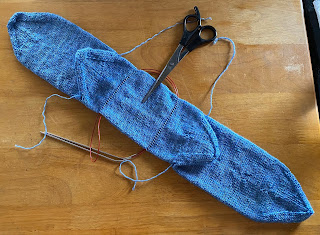During the inaugural summer of The Crafty Lady's pop up store, I knew it would be a little slow until customers found me in my new digs so (as I've mentioned before) I brought my sock knitting machine along to keep me occupied in the slow times. I still haven't experimented with the ribber but I have been making a lot of tubular sock blanks. Some of them have been with yarn I have for sale (so customers can see what the yarn looks like worked up) and some have been with my stash yarn. I alternate between store and stash yarn because I want to have one long continuous tube so I don't have to start a fresh tube from scratch - it can get messy.
But what can you do with a tube of sock yarn, you ask?
First and foremost, if you are working with a self patterning yarn, you can find all the places where the manufacturers joined new yarn ends in the most inappropriate places before you knit your actual sock. And if it isn't a self patterning yarn, it will help you find all the slubs and other imperfections that may affect the wearer's comfort. Who wants a knot in the middle of your arch?
Second, if you know that you usually use 80% of your 100g ball to make a pair of socks, you can use the information above to determine where to stop and start your two socks so that they are either identical or fraternal twins without wasting a boatload of yarn. You can now work straight from the tube and knit (or crochet) your favourite pattern without hesitation. It doesn't even have to be a sock! It could be mitts or gloves!
Third, you can make hybrid socks (machine and hand knit) using afterthought toes and heels. This method requires a little math but nothing too hard. For instance, I have been using a pointy looking afterthought toe/heel on these tubes that are ~2" long that decrease 4 stitches every two rounds until I reach 16 stitches (total 776 sts). Since the sock machine has 60 hooks, that is ~13 rounds of knitting (total 780 sts). I count back 15 rows (14 if there is a meter-ish long tail) from the raw edge - yes, it's raw. I'm not going to waste my time casting off something I'm just going to rip back! - use a fine (2.25mm) circular needle to run a lifeline, then frog down to the lifeline, making a nice neat little ball in the process. Knit your toe using this little ball of yarn. With my personal gauge, I use a 3mm needle to match the gauge of the machine. Others may need to go down a size or two.
Your heel can be made exactly the same way. Make sure to get an exact measurement of your toe length. Multiply it by 2 and subtract that number from the total desired length of your sock. For example, my foot is 9" long. With my gauge, my 21 row toe is 2" long. 2"x 2 = 4". 9"- 4" = 5" So, 5" from the base of my toe (or 7" from the tip of the toe) is where I run two 30 stitch lifelines centered directly below the toe shaping with one row between them.

But where do I get the yarn for the heel? Two possibilities - use a contrasting yarn, or decide how long you want your leg to be and cut your yarn 14-15 rows beyond that and use the yarn for the heel. For my most recent pairs (see final photo), I ended up snipping 23 rows above the top of my leg ribbing because I wanted to start at a full colour repeat.
If you want a plain vanilla sock, decide how much ribbing you want, run a lifeline at the lowest part of the ribbing, and pull back until you have live stitches on the needle(s). When you reach two rows fewer than what you pulled back, cast off. If you have a particular pattern in mind, pull back enough rows to accommodate the number of pattern repeats you would like and finish your sock.
Is this easier than starting your socks from scratch? That all depends on you. All I know is that I can cone and crank two balls of sock yarn in a half hour and I can make two pairs of short socks from one of them for Mom and me in less than a week using this method.

Sadly, I have to admit that there is one drawback to this method. The knitting machine is a left-handed knitter. That means there will be a tiny, mostly imperceptible, hole on one side of the toe since you will be essentially changing directions at that point. In my experience, wrap and turns are more noticeable and don't help.
If there is interest, I would gladly make this 'pattern' a class for this upcoming fall/winter season. Comment below (or on the Facebook post) if you would be interested.
written by Lori, happy TCL owner, who has been making good use of her downtime.



No comments:
Post a Comment